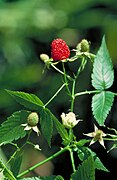Rubus queenslandicus
| Bramble-of-the-cape | |
|---|---|

| |
| Flower | |
| Scientific classification | |
| Kingdom: | Plantae |
| Clade: | Tracheophytes |
| Clade: | Angiosperms |
| Clade: | Eudicots |
| Clade: | Rosids |
| Order: | Rosales |
| Family: | Rosaceae |
| Genus: | Rubus |
| Species: | R. queenslandicus
|
| Binomial name | |
| Rubus queenslandicus | |

| |
Rubus queenslandicus, commonly known as bramble-of-the-cape, rose-leaf bramble, or native raspberry, is a plant in the rose family Rosaceae which is endemic to a small part of northeastern Queensland, Australia, where it is found on the margins of highland forest. Prior to 1997, collections of this plant were identified as either R. rosifolius, R. fraxinifolius or R. muelleri/R. probus.[4]: 677
Description[edit]
This species is an erect shrub growing up to about 1 m (3 ft 3 in) tall. The stems, petioles and rachises are glabrous, i.e. without hairs, but have small stout thorns about 3 mm (0.12 in) long. The compound leaves are glabrous and usually have five or seven leaflets, although those close to inflorescences may have three or one. The leaflet blades are narrowly ovate, the base obtuse and the tip acute or acuminate. The leaflet margins are bi- or triserrate, the teeth up to 3 mm (0.12 in) long, and each of the eight or nine lateral veins terminates at a major tooth.[4]: 683 [5][6][7]
The inflorescences are terminal or borne in the leaf axils, flowers carried on pedicels up to 3.5 cm (1.4 in) long. There are five pale sepals measuring up to 11 mm (0.43 in) by 4 mm (0.16 in) with a long acumen, narrowly triangular, persistent. The five petals are white, measure about 11 mm (0.43 in) long by 8 mm (0.31 in) wide, and are deciduous. The flowers have between 100 and 200 stamens measuring about 3.5 mm (0.14 in) long, and between 400 and 600 carpels.[4]: 683 [5][6][7]
The fruit is an ovoid or somewhat cylindrical aggregate fruit measuring about 13 mm (0.51 in) diameter and up to 18 mm (0.71 in) long, and is bright red at maturity.[4]: 683 [5][6][7]
Phenology[edit]
Flowering has been observed from May to November, and fruit between June and February.[4]: 685 [6]
Taxonomy[edit]
This species was first formally described by the Queensland botanist Anthony Bean based on a specimen collected by another Queensland botanist, Paul Irwin Forster, in the Mount Lewis National Park. Bean's paper, titled "A revision of Rubus subg. Idaeobatus (Focke) Focke (Rosaceae) in Australia", was published in 1997 in the journal Austrobaileya.[4]: 683
Etymology[edit]
The genus name Rubus is from the Latin word rubus meaning "blackberry" or "bramble". The species epithet queenslandicus refers to the Australian state to which this species is endemic.[4]: 685 [6]
Distribution and habitat[edit]
This species is restricted to highland areas of northeastern Queensland, from the Windsor Tablelands (adjacent to the Daintree National Park), south to Mount Fox (a little north of Townsville). However, most collections of the plant have been on the Atherton Tableland. It usually grows in disturbed areas of rainforest or on the forest's margins, at altitudes from about 680 m (2,230 ft) up to 1,200 m (3,900 ft).[4]: 684 [5]
Ecology[edit]
The fruit is eaten by numerous species of birds.[6]
Conservation[edit]
This species is listed by the Queensland Department of Environment and Science as least concern.[1] As of 18 January 2024[update], it has not been assessed by the International Union for Conservation of Nature (IUCN).
Gallery[edit]
-
Habit
-
Compound leaves
-
Flower close-up
-
Flowers and fruit
-
New fruit with persistent calyx
-
Ripe fruit
References[edit]
- ^ a b "Species profile—Rubus queenslandicus". Queensland Department of Environment and Science. Queensland Government. 2022. Retrieved 30 September 2023.
- ^ "Rubus queenslandicus". Australian Plant Name Index (APNI). Centre for Australian National Biodiversity Research, Australian Government. Retrieved 30 September 2023.
- ^ "Rubus queenslandicus A.R.Bean". Plants of the World Online. Royal Botanic Gardens, Kew. 2023. Retrieved 30 September 2023.
- ^ a b c d e f g h Bean, A.R. (1997). "A revision of Rubus subg. Idaeobatus (Focke) Focke (Rosaceae) in Australia". Austrobaileya. 4 (4): 677–689. JSTOR 41738901. Retrieved 30 September 2023.
- ^ a b c d F.A.Zich; B.P.M.Hyland; T.Whiffen; R.A.Kerrigan (2020). "Rubus queenslandicus". Australian Tropical Rainforest Plants Edition 8 (RFK8). Centre for Australian National Biodiversity Research (CANBR), Australian Government. Retrieved 30 September 2023.
- ^ a b c d e f Cooper, Wendy; Cooper, William T. (June 2004). Fruits of the Australian Tropical Rainforest. Clifton Hill, Victoria, Australia: Nokomis Editions. p. 431. ISBN 9780958174213.
- ^ a b c Bean, Tony (June 2001). "Queensland Raspberries". Australian Plants Online. Queensland: Australian Native Plants Society (Australian). Retrieved 30 September 2023.
External links[edit]
 Data related to Rubus queenslandicus at Wikispecies
Data related to Rubus queenslandicus at Wikispecies Media related to Rubus queenslandicus at Wikimedia Commons
Media related to Rubus queenslandicus at Wikimedia Commons- View a map of historical sightings of this species at the Australasian Virtual Herbarium
- View observations of this species on iNaturalist
- View images of this species on Flickriver






